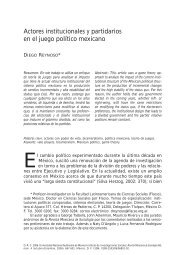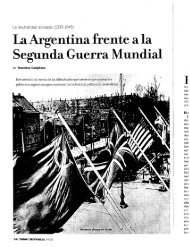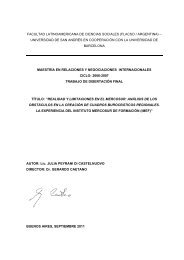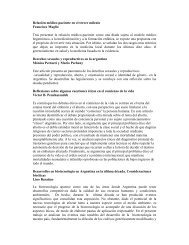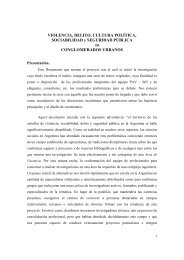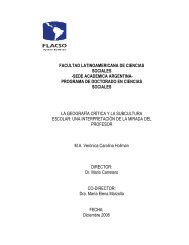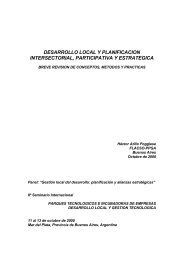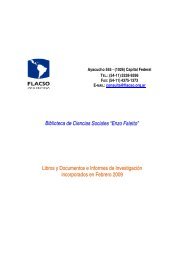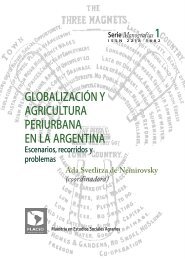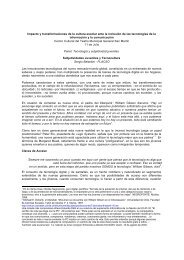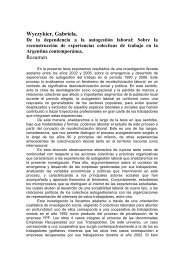Mercedes Botto Andrea Carla Bianculli - Flacso
Mercedes Botto Andrea Carla Bianculli - Flacso
Mercedes Botto Andrea Carla Bianculli - Flacso
You also want an ePaper? Increase the reach of your titles
YUMPU automatically turns print PDFs into web optimized ePapers that Google loves.
4. IMPACT EVALUATION: AN INITIAL COMPARATIVE ANALYSIS<br />
Along this section we will present a brief comparative analysis of both episodes in order to identify<br />
their similarities and differences in terms of the agenda-setting process, the production of<br />
knowledge, and its articulation with the policy-making process and utilization.<br />
When thinking in terms of the agenda-setting process, both episodes share a similar paradigm,<br />
which is clearly based on the idea promoted by international financial institutions – especially the<br />
World Bank – that portray trade liberalization policies undertaken as a change of paradigm, as being<br />
the unique possible solution to financial and economic crisis, and to growth problems as well.<br />
Promoted by the global epistemic community, this vision would find support at the domestic level:<br />
the economic and political elites were deeply convinced of the need of reform. However, the<br />
strategies designed and implemented by the first two democratic governments – the Radical<br />
administration, and the one led by the Peronist Party – would show important differences.<br />
The administration headed by Raúl Alfonsín followed the reform path proposed by the World<br />
Bank, but only partially. This government’s innovation was evident in the promotion of a trade<br />
liberalization process based on bilateral negotiations and tariff preferences, precisely when at the<br />
global level unilateral liberalization was actively promoted in order to deepen multilateralism. Thus,<br />
the negotiations initiated with Brazil would be structured around a set of sectoral agreements,<br />
which followed a clear logic of productive complementarity.<br />
On the contrary, the following administration strictly and unquestionably followed the policy<br />
recommendations of the so-called Washington Consensus, which mainly consisted of an<br />
indiscriminate opening of the economy at all levels – unilateral, regional, and multilateral – together<br />
with the establishment of high exchange rates. At the regional level, the logic of the integration<br />
process with Brazil changed dramatically. Negotiations with Brazil, and with Paraguay and Uruguay<br />
in order to create Mercosur, were only aimed at attaining a free trade zone and a zero tariff within a<br />
period of five years. The proposal of creating a customs union would be brought about by the<br />
larger partners – Argentina and Brazil – that clearly needed to establish a lock-in mechanism for the<br />
trade liberalization already achieved, and to resist the pressures of protectionist sectors interested in<br />
reversing the process.<br />
When analyzing the academic production that influenced on the design of these strategies, both<br />
experiences exhibit great similarities. In both cases, governments were faced with new challenges,<br />
but they also lacked the basic expertise and information required to effectively implement these<br />
transformations. This would not be the case with the private sector, where a reduced group<br />
comprising the most concentrated industries that were in need of wider markets, had undergone a<br />
“regional” learning process since the negotiations within LAIA. Unlike governments, these<br />
companies had constructed continuity in time and had developed an increasing professionalization<br />
of their staff members.<br />
34



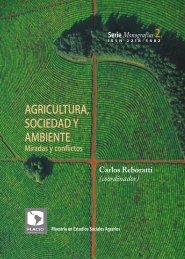
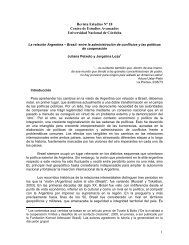
![[P] Disertacion.Melisa.Galvano.pdf - Flacso](https://img.yumpu.com/14596629/1/184x260/p-disertacionmelisagalvanopdf-flacso.jpg?quality=85)
